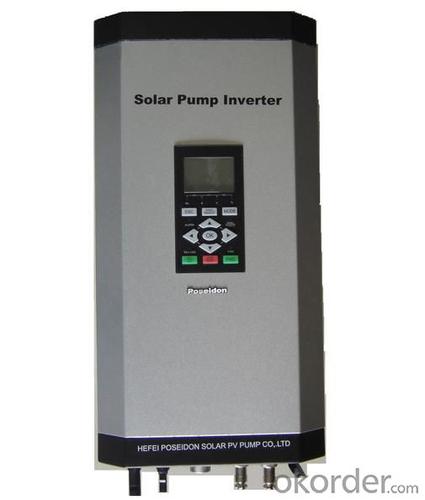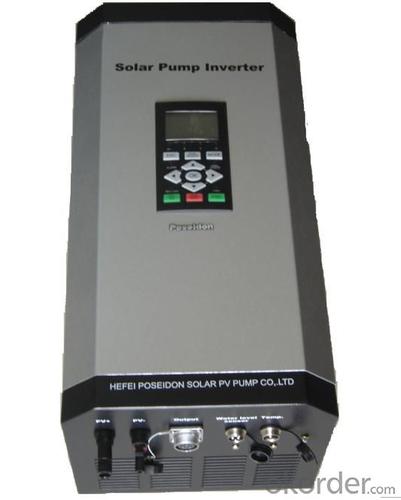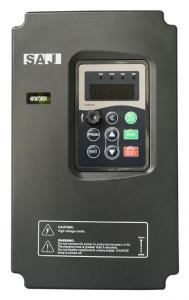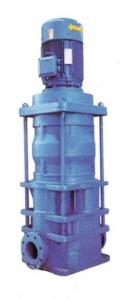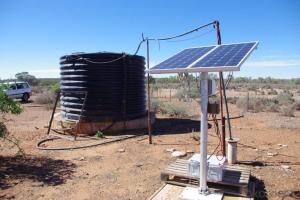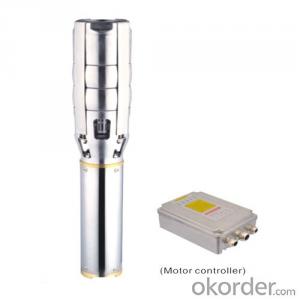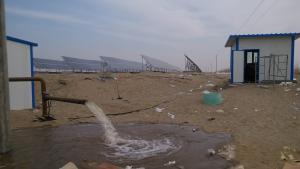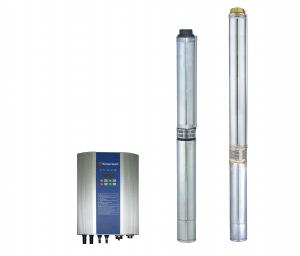Solar Pump 3 Hp FCPM100KH Inverter
- Loading Port:
- China Main Port
- Payment Terms:
- TT OR LC
- Min Order Qty:
- -
- Supply Capability:
- -
OKorder Service Pledge
Quality Product, Order Online Tracking, Timely Delivery
OKorder Financial Service
Credit Rating, Credit Services, Credit Purchasing
You Might Also Like
Solar pump inverter FCPM75KH Product Description:
Solar water pumping system is constructed with solar panel array,solar pump inverter and AC water pump, DC current produced from solar panel will be delivered to solar pump inverter,and it will convert it into AC current to drive water pump,and will automatically regulate output frequency according to sun radiance intensity,maximally realize MPPT tracking function.
Features
Adopting the proposed dynamic VI maximum power point tracking (MPPT) control method, with fast response, and reliable operation, achieves efficiency of 99%.
Designed with variable frequency driver, greatly improves efficiency
Extremely high efficiency
Digital mode control, with automatic operation and manual operation mode options
Complete protection functions
Adopts intelligent IPM module, with high reliability
LCD display and operation panel, in real time presents operating data
Optional for water level measurement and control circuit
Applicable for general ACC pumps, like centrifugal pump, piston pump etc.
Independent intellectual property; Highly effective, the redundant reliability, exempts the maintenance and the long life.
The pumps are soft started, fully protected.
No batteries are used. So better Sunlight, more water.
Datasheet.

- Q: Can a solar pump work at night or on cloudy days?
- Solar pumps are unable to operate at night or during cloudy days. They depend on sunlight to produce electricity, which then energizes the pump to extract water. In the absence of sunlight, the pump lacks the necessary energy source to operate. Consequently, solar pumps are exclusively designed for use during daylight hours when ample sunlight is present.
- Q: Do solar pumps require batteries for storage?
- Solar pumps do not need batteries for storage. They are specifically designed to function by directly utilizing the energy produced by the sun. When the sun is present, the solar panels convert sunlight into electrical energy, which powers the pump. This enables the pump to operate in real-time, extracting water directly from the source and delivering it to the desired location, such as a reservoir or irrigation system. Because solar pumps do not depend on batteries for storage, they are generally more cost-effective and require less maintenance compared to pumps that rely on batteries. However, it is important to mention that certain solar pump systems may incorporate a small battery for short-term energy storage. This ensures uninterrupted operation during periods of low sunlight or at night.
- Q: Can a solar pump be used for large-scale agricultural irrigation?
- Yes, a solar pump can be used for large-scale agricultural irrigation. Solar pumps are a cost-effective and sustainable solution that can efficiently deliver water to various agricultural fields. They can provide a consistent water supply, reduce dependency on fossil fuels, and lower operational costs. Additionally, solar pumps can be integrated with advanced irrigation systems to optimize water usage and improve crop yields.
- Q: Can a solar pump be used for desalination of seawater?
- Yes, a solar pump can be used for the desalination of seawater. Solar pumps are commonly used in combination with desalination systems to provide the necessary energy for the process. Solar-powered desalination systems utilize the energy from the sun to power the pump, which in turn drives the seawater through the desalination unit. This process typically involves reverse osmosis or distillation to remove the salt and impurities from the seawater, resulting in fresh drinking water. The use of solar pumps for desalination offers several advantages, such as being environmentally friendly, renewable, and cost-effective in the long run, as they do not require any external power sources. The availability of abundant sunlight in coastal areas makes solar pumps an ideal choice for desalination projects in regions where freshwater scarcity is a pressing issue.
- Q: Can solar pumps be used for water supply in off-grid cabins or vacation homes?
- Yes, solar pumps can definitely be used for water supply in off-grid cabins or vacation homes. Solar pumps are a reliable and sustainable option for extracting water from wells, rivers, or other water sources without requiring access to the electrical grid. They operate using solar energy, which is abundant in most locations and can be stored in batteries for continuous water supply even during overcast days or at night. This makes solar pumps an ideal solution for off-grid cabins or vacation homes where traditional electricity may not be readily available.
- Q: Can a solar pump be used in areas with high levels of radon in the water?
- No, a solar pump cannot be used in areas with high levels of radon in the water. Radon is a radioactive gas that can be harmful to human health, and it is important to avoid its exposure. Using a solar pump in such areas would not mitigate the presence of radon in the water, making it unsafe for consumption or use. A different water pumping solution should be considered in these circumstances.
- Q: Are there any specific requirements for the solar panel installation of a solar pump?
- Yes, there are specific requirements for the solar panel installation of a solar pump. Here are some key considerations: 1. Solar panel capacity: The solar panel system should have sufficient capacity to generate the necessary energy to power the solar pump. This depends on factors such as the pump's power requirements, daily water demand, and location's solar irradiation levels. It is crucial to accurately calculate the required capacity to ensure optimal performance. 2. Orientation and tilt: The solar panels should be installed in a location that receives maximum sunlight exposure throughout the day. The ideal orientation is facing south (in the Northern Hemisphere) or north (in the Southern Hemisphere) to capture the most sunlight. Additionally, the tilt angle of the solar panels should be set to optimize energy production based on the geographical latitude. 3. Shading: It is essential to avoid any shading on the solar panels, as even partial shading can significantly reduce their efficiency. Prior to installation, a thorough assessment of the surrounding environment should be conducted to identify potential shading sources, such as trees, buildings, or other structures. The solar panels should be positioned in an area with minimal shading. 4. Mounting structure: The solar panels must be securely mounted to withstand environmental conditions like wind, snow, and potential natural disasters. Depending on the installation location, the appropriate mounting structure should be selected, such as roof-mounted, ground-mounted, or pole-mounted systems. The structure should ensure proper ventilation and maintenance access for the solar panels. 5. Wiring and electrical connections: The wiring for the solar panels should be correctly sized to handle the electrical load and minimize energy losses. It is crucial to follow local electrical codes and safety guidelines during the installation process. Proper grounding and connection to the solar pump system are also important to ensure safe and efficient operation. 6. Maintenance and monitoring: Regular maintenance of the solar panels is necessary to ensure optimal performance and longevity. This includes cleaning the panels from dust, dirt, or debris and inspecting for any damage. Additionally, monitoring systems can be installed to track the energy generation and diagnose any potential issues promptly. It is important to consult with a qualified solar installer or engineer to determine the specific requirements for the solar panel installation of a solar pump, as they can provide expertise tailored to your specific needs and location.
- Q: How does a solar pump handle power fluctuations or surges?
- A solar pump typically handles power fluctuations or surges by having built-in protection mechanisms. These mechanisms can include voltage regulators, surge protectors, and inverters that convert DC power from the solar panels into stable AC power for the pump. This helps ensure that the pump receives a consistent and reliable power supply, even when there are fluctuations or surges in the solar power output.
- Q: Are there any specific certifications or standards for solar pumps?
- Yes, there are specific certifications and standards for solar pumps. Some commonly recognized certifications include the International Electrotechnical Commission (IEC) 62109-1 for safety of power converters, and the International Organization for Standardization (ISO) 9001 for quality management systems. Additionally, there are various regional and national standards that may apply, depending on the country or region where the solar pump is being used. These certifications and standards ensure that solar pumps meet the required safety, performance, and quality criteria.
- Q: How does a solar pump handle water flow rate adjustments?
- A solar pump typically handles water flow rate adjustments through the use of a controller. The controller allows the user to manually adjust the speed of the pump or set it to operate at a specific flow rate. Additionally, some solar pumps are equipped with sensors that automatically adjust the flow rate based on the amount of sunlight available, ensuring optimal performance and efficiency.
Send your message to us
Solar Pump 3 Hp FCPM100KH Inverter
- Loading Port:
- China Main Port
- Payment Terms:
- TT OR LC
- Min Order Qty:
- -
- Supply Capability:
- -
OKorder Service Pledge
Quality Product, Order Online Tracking, Timely Delivery
OKorder Financial Service
Credit Rating, Credit Services, Credit Purchasing
Similar products
Hot products
Hot Searches
Related keywords




